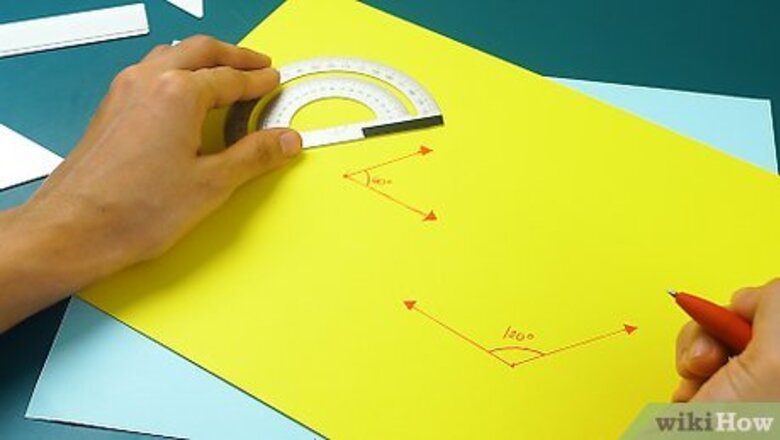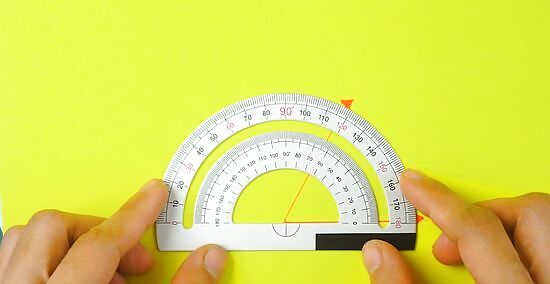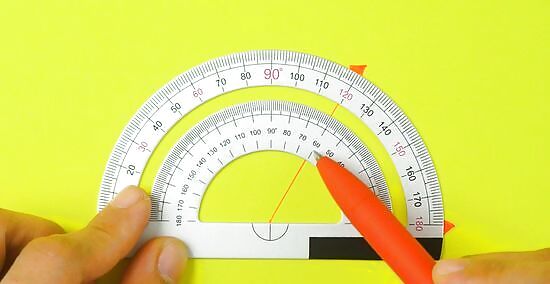
views
- Place the small hole or vertical line at the bottom center of your protractor over the vertex of your angle, or where the 2 lines meet.
- Then, adjust your protractor so 1 of the angle’s rays, or lines, is straight and flush against the 0° measurement.
- Start at 0° and follow the scale measurements up to where the other line passes through the protractor. The number it falls on is your angle’s measurement.
Measuring an Angle with a Protractor

Examine whether your angle is acute, obtuse, or right. Most protractors have 2 sets of measurements along its arc, so looking at and classifying your angle helps you identify which scale to use. Acute angles are narrow and less than 90°, while obtuse angles are wide and greater than 90°. Right angles are exactly 90° and formed from 2 perpendicular rays, or lines. On most protractors, 1 scale starts from 0° on the right and ends at 180° on the left, while the other starts from 0° the left and ends at 180° on the right. In the above example, the 60° angle is acute because it has a narrow opening and is less than 90°. The 120° angle is obtuse because it’s wide and greater than 90°. In geometry, a ray is a line that has an endpoint on 1 side but not on the other.

Place the center point of the protractor over the vertex of the angle. Look towards the bottom middle of your protractor. Some protractors have a small hole in the center, while others have a short vertical line. This center point on your protractor is called the origin. Simply place the origin at the vertex of the angle, or where the 2 lines meet and come to a point. Either set the hole over the vertex, or align it against the bottom of the vertical line.

Line 1 of the angle’s rays flush against the 0° measurement. To accurately measure your angle, 1 of the angle’s rays has to go through the 0° mark on your protractor. If your protractor isn’t already lined up against 1 ray, carefully turn it while keeping the origin over the vertex of the angle. Then, stop adjusting the protractor once the ray is straight and flush against the 0° line on the protractor. The 0° line is aligned with the origin of your protractor and starts from both the left and right sides. Some protractors have more than 1 straight, horizontal edge, which can make aligning it with a ray confusing. Just make sure the ray passes through 0° and not a different measurement.

Follow the other ray up to the measurements on the protractor's arc. Use the scale measurements that are increasing in the direction that your angle is opening up in. If it’s an acute angle, make sure you’re looking at the measurements that are less than 90°. If your angle is obtuse, use the scale with measurements greater than 90°. The number that the ray passes through is your angle’s measurement in degrees. In the above image, the angle opens up to the right and is acute. We know to use the scale on the inside because the measurements are increasing as you move towards the line and they’re less than 90°. If this angle opened from the left, you’d use the outer scale. If the line doesn’t extend past the protractor’s arc, lengthen it with a ruler. Or, line the edge of a piece of paper along the line. Protractors typically label measurements in 10s, but between each number are little lines that represent 1°. If your ray falls in between 2 whole numbers, like 50° and 60°, just count the lines to find your angle’s exact measurement. The 2 measurement scales on the protractor makes this tool handy for measuring angles that open up from either direction.
Drawing an Angle with a Protractor

Draw a straight, horizontal line. Use a ruler or the straight edge of your protractor to draw your reference line, or the first ray of your angle. Make this line horizontal and any length you like. The length of the line doesn’t matter.

Place the hole or vertical line on your protractor at 1 end of the line. Choose whether you want to make the vertex of your angle, or the point where the 2 lines meet, at the left or right end of your horizontal line. Then, mark a small dot at the vertex point. Line the origin, or the center point, of your protractor over the vertex. You don’t have to place the vertex at the end of the line. It can go anywhere on the line, but it is typically easier to use the end of the line.
Straighten the horizontal line against the 0° mark on your protractor. Rotate your protractor carefully so the horizontal line is straight and flush against either 0° measurement. Then, make sure the origin of the protractor is still over the vertex of your line. This ensures that your angle is exact. If your protractor has more than 1 straight edge, remember that the 0° line is aligned with the origin.

Mark the angle degree you want to draw using the protractor's scale. Move up your protractor’s scale from 0° and find the measurement you want for your angle. If you’re drawing an acute angle, make sure you’re looking at the scale numbers that are less than 90°. If you’re drawing an obtuse angle, use the scale numbers that are greater than 90°. Then, simply draw a dot at the measurement. In the above example, the angle is 60°.

Draw the angle’s second ray from the point you marked to the vertex. Using a ruler, the flat edge of your protractor, or another straight edge, connect the vertex to the degree measurement you marked. You now have your second ray and a complete angle. Then, to verify that you drew the angle correctly, use your protractor to measure it.



















Comments
0 comment